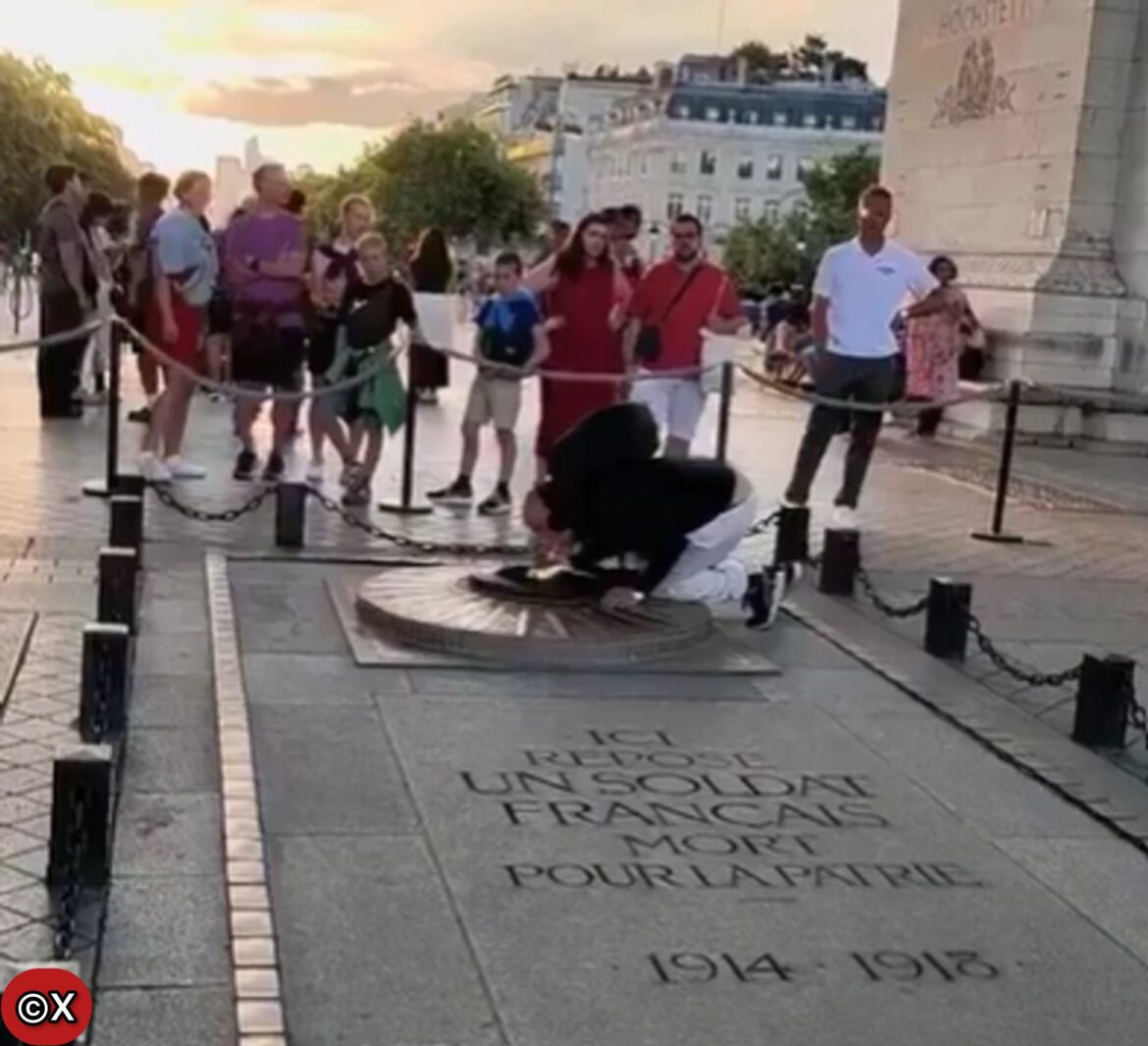A 47-year-old Moroccan national faces criminal charges and deportation after desecrating France’s most sacred war memorial by using its eternal flame to light a cigarette, sparking fury across the nation and swift condemnation from government ministers.
The shocking incident occurred on Monday evening at the Tomb of the Unknown Soldier beneath the Arc de Triomphe, where footage captured the man stepping over protective barriers before crouching to ignite his cigarette from the flame that has burned continuously since 1923. The video, initially posted on TikTok by a Latvian tourist, spread rapidly across social media platforms, drawing widespread condemnation.
French Interior Minister Bruno Retailleau condemned the act on X, declaring: “This unworthy and deplorable act undermines the memory of those who died for France.” He confirmed the suspect was arrested on Tuesday afternoon in Paris and had confessed to the offence during police custody.
Veterans Minister Patricia Miralles expressed outrage at what she called a desecration rather than a mere transgression. “Walking on the Tomb of the Unknown Soldier. Lighting his cigarette with the eternal flame. This is not a simple deviation, it is a desecration,” she posted on X. “France will never tolerate tarnishing the memory of those who died for her. Never.”
The suspect, identified in French media as Hamdi H., has been charged with violating a burial site and memorial dedicated to the deceased, which carries potential penalties of up to twelve months’ imprisonment and fines reaching €15,000 (£12,800). According to Le Figaro, the man has 21 entries in the criminal record database, including offences for car theft, vandalism, assault, and racially aggravated public insults.
Miralles announced her intention to pursue legal action, stating: “I am filing a case immediately with the Paris state prosecutor to make an example of him.” Sources indicate that Retailleau plans to revoke the individual’s residence permit, which currently extends through October 2025, paving the way for his deportation from France.
The Latvian tourist who filmed the incident told Le Figaro that the man did not appear drunk and seemed fully aware of his actions. Witnesses reported their shock as the man calmly walked away after committing the act, with several tourists watching in disbelief.
“This flame does not light a cigarette, it burns for the sacrifice of millions of our soldiers,” Miralles emphasised in her statement, underlining the profound disrespect shown to France’s war dead.
The Tomb of the Unknown Soldier holds exceptional significance in French national memory. Established on 11 November 1920, it contains the remains of an unidentified French soldier killed during the First World War, symbolically representing all French soldiers who have died for their country throughout history.
The unknown soldier was selected from eight unidentified bodies exhumed from different battlefields where the deadliest fighting had occurred, including Flanders, Artois, the Somme, Champagne, and Verdun. On 10 November 1920, 21-year-old Private Auguste Thin was tasked with choosing which soldier would rest beneath the Arc de Triomphe. He selected the sixth coffin, later explaining he chose it because his military unit was the sixth regiment.
The body was transported to Paris and, following a solemn procession witnessed by hundreds of thousands, was placed in a chapel within the Arc de Triomphe. The final burial took place on 28 January 1921, in the presence of Marshal Ferdinand Foch, Marshal Joseph Joffre, Marshal Philippe Pétain, British Prime Minister David Lloyd George, and other dignitaries.
The granite slab marking the tomb bears the inscription: “Ici repose un soldat français mort pour la Patrie, 1914–1918″ (“Here rests a French soldier who died for the Fatherland, 1914–1918”). The site is surrounded by black metal posts linked by chains, creating a sacred space at the centre of the monument.
The eternal flame was added in 1923, initially lit by then War Minister André Maginot. Originally intended to be rekindled only on Armistice Day, journalists Gabriel Boissy and Jacques Péricard successfully campaigned for it to be relit daily. Since then, a ceremony has taken place every evening at 18:30, where veterans’ associations and officials rekindle the flame in a solemn ritual.
The monument serves as France’s principal tribute to its war dead and has witnessed numerous historic moments. Since 1920, all military parades, including those of occupying forces and liberating armies, have consciously avoided marching directly under the Arc out of respect for the tomb, instead processing around its side.
This is not the first time the memorial has been desecrated. In 1927, riots following the execution of anarchists Sacco and Vanzetti led to damage at the site, prompting the creation of the Croix-de-Feu political movement. The eternal flame was briefly extinguished in 1998 by a drunk tourist during the World Cup celebrations.
The Arc de Triomphe itself, commissioned by Napoleon Bonaparte in 1806 to honour French military victories, stands 50 metres tall at the western end of the Champs-Élysées. Designed by architect Jean Chalgrin and completed in 1836, it bears the names of French victories and generals inscribed on its surfaces.
France’s approach to honouring its unknown war dead parallels similar memorials in other nations, including the Tomb of the Unknown Warrior at Westminster Abbey in London and the Tomb of the Unknown Soldier at Arlington National Cemetery in the United States. These monuments collectively represent the shared sacrifice of nations during the First World War and subsequent conflicts.
The incident has reignited discussions about respect for national monuments and the importance of preserving sites of remembrance. The Association La Flamme sous l’Arc de Triomphe, founded in 1925 to oversee the eternal flame ceremonies, expressed its dismay at the desecration of what veterans call “the sacred slab.”
As legal proceedings continue, authorities have emphasised that such acts of disrespect towards France’s war memorials will face the full force of the law. The case serves as a stark reminder of the enduring significance of war memorials in national consciousness and the duty to protect these sacred sites from desecration.
Follow for more updates on Britannia Daily



